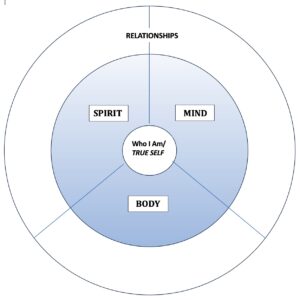Most leadership practices — whether in business, government, community service, labour unions and the not-for-profit sector — are still operating as though we live in the dark ages of the Industrial Revolution not the high-tech, high-touch Age of Innovation. An unwillingness to disrupt the old practices of command and control with the newer skills of consult and coach place us in what many refer to as a global leadership crisis where disillusionment and mistrust prevail. In a 2014 Ketchum leadership and communication survey of 6,500 people in 13 countries across 5 continents,
only 22% of those surveyed feel leaders are demonstrating
effective leadership — down from last year — and even fewer than that are optimistic about seeing any improvement in leadership over the coming year.
There is no question that global leadership practices are stuck in a stubborn pattern, but what is the root cause of their ineffectiveness? Ketchum’s 2014 survey correlates effective leadership with effective communication. As we know, correlation does not define a cause and effect relationship. Therefore, we cannot say ineffective communication causes ineffective leadership or vice versa. However, we can state that when communication in an organization is effective so is leadership. Systems theory tells us that a system’s culture (leadership and communication) is defined and determined by the design of its structure. In other words, organizations are unlikely to change their leadership style and culture without first changing their structure. The simple image below illustrates this point.
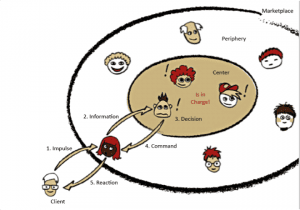
In a centralized organization structure where the decisions are made by a few who then tell the many how and what to implement, the hierarchical structure of command and control prevails. People work in ‘silo’ functions where asking permission is often more important than meeting the customers’ needs.
The interaction between a client and the centralized system requires, at best, five steps in the workflow process — the initial request from the client, the information request to the manager from the customer service representative, the manager’s decision, the decision handed down to the representative and finally the representative’s response to the client. Imagine how many steps might be necessary if there were four or five levels of management instead of only the one portrayed here.
Our experience with the campfire game of whispering a brief message into an ear, which is then sequentially passed around the circle one ear at-a-time, is a reminder of how communication is easily misinterpreted and/or distorted with each new telling. Furthermore, the more steps in any non-automated workflow process, the more complicated the process becomes, the more prone it is to errors and rework, and necessarily, the less effective and efficient.
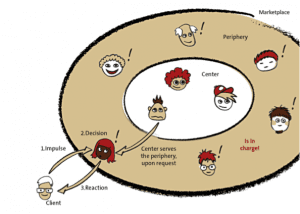
Conversely, in a decentralized organization structure decision-making and leadership are the responsibility of those who first connect with the clients and who are doing work that adds value to the customer. Use of the organization’s central/support services comes as a request from these representatives when required. This distribution of decision-making and leadership throughout the organization simplifies and speeds-up workflow processes enabling organizational adaptation and innovation, which certainly can include added efficiency and effectiveness.
It is unlikely that anyone reading this will find any of it surprising. Globally, we have been living within the tension of restructuring from centralized to decentralized organization structures for several decades. Today’s added complexity, in moving out of the Industrial Age through the Information Age to finally land in the Innovation Age, is that decentralized structures are typically team-based in order to handle what has emerged in the market place — more competition, more workflows (products and/or services) and more uncertainty. These decentralized structures look more like interconnected networks than organizations with concrete boundaries. In previous blogs, I referred to them as value-realization networks (VRNs) and issue-based ecosystems (IBES). Their boundaries (see image below) are organized around complete pieces of work not around functions/silos, and their teams are multi-functional with several roles existing within each team.
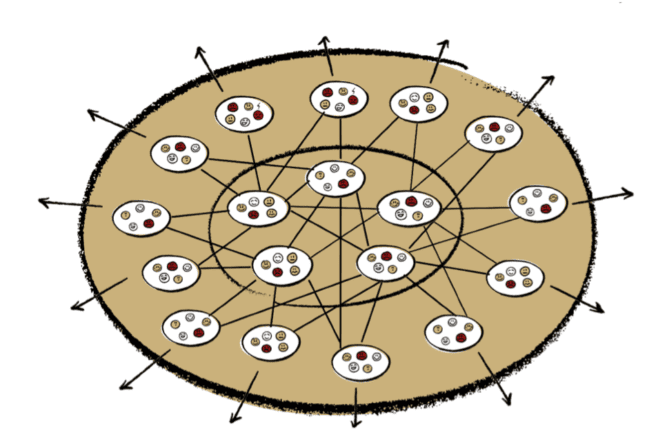
Decentralized Network (Self-Managed Team) Structure
Although our lives are more complex and uncertain, whether at work or at home, they do not need to be more complicated. Those organizations still operating under a centralized structure, even when efficiency and scale are no longer their prime strategies, over-complicate their businesses as well as over-complicate their customers’ experiences. Over-specialization in these functional silo organizations restricts both employee involvement in the work process from beginning to end and an understanding of how their contribution makes a difference. Tragically, no one in the organization is able to be responsible to clients when they are looking up to their bosses rather than out to their customers.
As Niels Pflaeging states in his 2014 book, Organize for Complexity, the existing need for stable processes and innovation demands we collaboratively design organizations to navigate the amount of uncertainty confronting us. Just as we can no longer leave organizational decision-making and leadership to a few managers, we must distribute organizational design knowledge, skills and decisions throughout the entire organization. In decentralized (adaptive and innovative) organizations, everyone needs to be continuously redesigning the system to align it with the continuously changing external environment of customer expectations and market demands. As our society grows and matures (see image below), so does the degree of complexity confronting us on a daily basis.
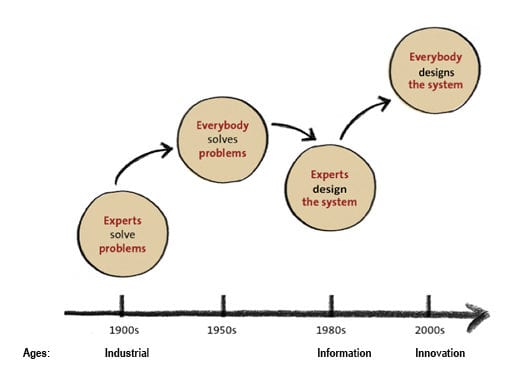
In times of complexity and rapid change, we need to integrate every bit of intelligence available (emotional, social, intellectual, spiritual, economic, political, etc.) to both stabilize our existing foundations and innovate new responses to new challenges.
Look around you at home and at work. With what new ways of working do you find yourself experimenting to stabilize and grow your experiences?
For more on innovative leadership, click here.



